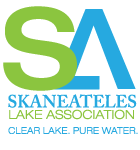Ice, snow, and rain runoff that contains salt ladened de-icers can be harmful to the lake by carrying pollutants into our waterways and causing problems for the environment. Salt can impact a plant’s ability to absorb nutrients that we want to keep out of the lake.
Your walk or driveway may not cause much harm individually, but with an estimated 15 million tons of de-icing salt used per year in the U.S., all that salt has to end up somewhere. The salt can eventually seep into the ground or runoff into streams and lakes.
There are four main types of de-icers:
- Rock salt (sodium chloride) is very abundant in CNY, less expensive, and most widely applied. It can be toxic to underwater life and is the most harmful for plants due to its high chloride levels.
- Calcium chloride is a more expensive than rock salt, but not as much is needed. It is effective at temperatures down to -25°F, but it can also harm plants because of chloride.
- Magnesium chloride doesn’t add as much chloride compared to rock salt and calcium chloride, and can be considered less of a concern for the environment.
- Calcium magnesium acetate (CMA) is considered the best choice for safely melting ice. It costs more, but it can melt ice at a lower temperature, does not require as much to get the job done and does not impact plant nutrient and water uptake like rock salt.
Tips for snow and ice removal include:
- Look for “pet safe” de-icing products. If a product is pet friendly, it is likely to be eco-friendly.
- Apply de-icing products before a winter storm.
- Clear as much snow and ice before applying de-icing products.
- Don’t use salt as a substitute for shoveling.
- Only use the necessary de-icer amount. A mechanical spreader can help achieve proper coverage.
We all can do more to protect our precious water quality. If we act together, we can collectively be the solution to winter pollution.

